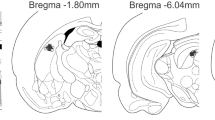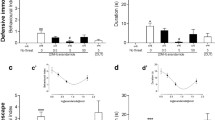Abstract
Rationale
Direct activation of the cannabinoid CB1 receptor in the dorsolateral periaqueductal gray (dlPAG) inhibits anxiety- and panic-related behaviours in experimental animals. It has remained unclear, however, whether the local endocannabinoid signalling is recruited as a protective mechanism against aversive stimuli.
Objectives
The present study tested the hypothesis that the endocannabinoid system counteracts aversive responses in the dlPAG-stimulation model of panic attacks.
Methods
All drugs were infused into the dlPAG of rats. Local chemical stimulation with N-methyl-d-aspartate (NMDA, 1 nmol) was employed to induce panic-like behavioural and cardiovascular responses in freely moving and anaesthetized animals, respectively. The neuronal activity in the dlPAG was investigated by c-Fos immunohistochemistry.
Results
The selective CB1 receptor agonist, ACEA (0.005–0.5 pmol), prevented the NMDA-induced panic-like escape responses. More interestingly, increasing the local levels of endogenous anandamide with a fatty acid amide hydrolase (FAAH) inhibitor, URB597 (0.3–3 nmol), prevented both the behavioural response and the increase in blood pressure induced by NMDA. The effect of URB597 (3 nmol) was reversed by the CB1 receptor antagonist, AM251 (0.1 nmol). Moreover, an otherwise ineffective and sub-threshold dose of NMDA (0.5 nmol) was able to induce a panic-like response if local CB1 receptors were previously blocked by AM251 (0.1 nmol). Finally, URB597 prevented the NMDA-induced neuronal activation of the dlPAG.
Conclusions
The endocannabinoid system in the dlPAG attenuates the behavioural, cellular and cardiovascular consequences of aversive stimuli. This process may be considered for the development of additional treatments against panic and other anxiety-related disorders.








Similar content being viewed by others
References
Aguiar DC, Moreira FA, Guimaraes FS (2006) Flight reactions induced by injection of glutamate N-methyl-d-aspartate receptor agonist into the rat dorsolateral periaqueductal gray are not dependent on endogenous nitric oxide. Pharmacol Biochem Behav 83:296–301
Almeida-Santos AF, Moreira FA, Guimaraes FS, Aguiar DC (2013) Role of TRPV1 receptors on panic-like behaviors mediated by the dorsolateral periaqueductal gray in rats. Pharmacol Biochem Behav 105:166–172
Bandler R, Keay KA, Floyd N, Price J (2000) Central circuits mediating patterned autonomic activity during active vs. passive emotional coping. Brain Res Bull 53:95–104
Batista LA, Gobira PH, Viana TG, Aguiar DC, Moreira FA (2014) Inhibition of endocannabinoid neuronal uptake and hydrolysis as strategies for developing anxiolytic drugs. Behav Pharmacol 25:425–433
Beijamini V, Guimarães FS (2006) Activation of neurons containing the enzyme nitric oxide synthase following exposure to an elevated plus maze. Brain Res Bull 69:347-355
Blankman JL, Cravatt BF (2013) Chemical probes of endocannabinoid metabolism. Pharmacol Rev 65:849–871
Casarotto PC, Terzian AL, Aguiar DC, Zangrossi H, Guimaraes FS, Wotjak CT, Moreira FA (2012) Opposing roles for cannabinoid receptor type-1 (CB(1)) and transient receptor potential vanilloid type-1 channel (TRPV1) on the modulation of panic-like responses in rats. Neuropsychopharmacology 37:478–486
de Menezes RC, Zaretsky DV, Fontes MA, DiMicco JA (2009) Cardiovascular and hermal responses evoked from the periaqueductal grey require neuronal activity in the hypothalamus. J Physiol 587:1201–1215
Devane WA, Dysarz FA 3rd, Johnson MR, Melvin LS, Howlett AC (1988) Determination and characterization of a cannabinoid receptor in rat brain. Mol Pharmacol 34:605–613
Ferreira-Netto C, Borelli KG, Brandao ML (2005) Neural segregation of Fos-protein distribution in the brain following freezing and escape behaviors induced by injections of either glutamate or NMDA into the dorsal periaqueductal gray of rats. Brain Res 1031:151–163
Finn DP, Jhaveri MD, Beckett SR, Roe CH, Kendall DA, Marsden CA, Chapman V (2003) Effects of direct periaqueductal grey administration of a cannabinoid receptor agonist on nociceptive and aversive responses in rats. Neuropharmacology 45:594–604
Goani Y, Mechoulam R (1964) Isolation, structure and partial synthesis of an active constituent of hashish. J Am Chem Soc 86:1646–1647
Herkenham M, Lynn AB, Johnson MR, Melvin LS, de Costa BR, Rice KC (1991) Characterization and localization of cannabinoid receptors in rat brain: a quantitative in vitro autoradiographic study. J Neurosci 11:563–583
Hohmann AG, Suplita RL, Bolton NM, Neely MH, Fegley D, Mangieri R, Krey JF, Walker JM, Holmes PV, Crystal JD, Duranti A, Tontini A, Mor M, Tarzia G, Piomelli D (2005) An endocannabinoid mechanism for stress-induced analgesia. Nature 435:1108–1112
Johnson PL, Federici LM, Shekhar A (2014) Etiology, triggers and neurochemical circuits associated with unexpected, expected, and laboratory-induced panic attacks. Neurosci Biobehav Rev. doi:10.1016/j.neubiorev.2014.07.027
Kathuria S, Gaetani S, Fegley D, Valino F, Duranti A, Tontini A, Mor M, Tarzia G, La Rana G, Calignano A, Giustino A, Tattoli M, Palmery M, Cuomo V, Piomelli D (2003) Modulation of anxiety through blockade of anandamide hydrolysis. Nat Med 9:76–81
Kawahara H, Drew GM, Christie MJ, Vaughan CW (2011) Inhibition of fatty acid amide hydrolase unmasks CB1 receptor and TRPV1 channel-mediated modulation of glutamatergic synaptic transmission in midbrain periaqueductal grey. Br J Pharmacol 163:1214–1222
Krieger JE, Graeff FG (1985) Defensive behavior and hypertension induced by glutamate in the midbrain central gray of the rat. Braz J Med Biol Res 18:61–67
Lisboa SF, Resstel LB, Aguiar DC, Guimaraes FS (2008) Activation of cannabinoid CB1 receptors in the dorsolateral periaqueductal gray induces anxiolytic effects in rats submitted to the Vogel conflict test. Eur J Pharmacol 593:73–78
Martin M, Ledent C, Parmentier M, Maldonado R, Valverde O (2002) Involvement of CB1 cannabinoid receptors in emotional behaviour. Psychopharmacology (Berlin) 159:379–387
Matsuda LA, Lolait SJ, Brownstein MJ, Young AC, Bonner TI (1990) Structure of a cannabinoid receptor and functional expression of the cloned cDNA. Nature 346:561–564
Moreira FA, Aguiar DC, Guimaraes FS (2007) Anxiolytic-like effect of cannabinoids injected into the rat dorsolateral periaqueductal gray. Neuropharmacology 52:958–965
Moreira FA, Kaiser N, Monory K, Lutz B (2008) Reduced anxiety-like behaviour induced by genetic and pharmacological inhibition of the endocannabinoid-degrading enzyme fatty acid amide hydrolase (FAAH) is mediated by CB1 receptors. Neuropharmacology 54:141–150
Moreira FA, Aguiar DC, Resstel LB, Lisboa SF, Campos AC, Gomes FV, Guimarães FS (2012) Neuroanatomical substrates involved in cannabinoid modulation of defensive responses. J Psychopharmacol 26:40–55
Moreira FA, Gobira PH, Viana TG, Vicente MA, Zangrossi H, Graeff FG (2013) Modeling panic disorder in rodents. Cell Tissue Res 354:119–125
Patel S, Hillard CJ (2006) Pharmacological evaluation of cannabinoid receptor ligands in a mouse model of anxiety: further evidence for an anxiolytic role for endogenous cannabinoid signaling. J Pharmacol Exp Ther 318:304–311
Paxinos G, Watson C (1997) The rat brain in stereotaxic coordinates. Academic Press 3rd ed.
Pertwee RG, Howlett AC, Abood ME, Alexander SP, Di Marzo V, Elphick MR, Greasley PJ, Hansen HS, Kunos G, Mackie K, Mechoulam R, Ross RA (2010) International Union of Basic and Clinical Pharmacology. LXXIX. Cannabinoid receptors and their ligands: beyond CB1 and CB2. Pharmacol Rev 62:588–631
Piomelli D (2003) The molecular logic of endocannabinoid signalling. Nat Rev Neurosci 4:873–884
Resstel LB, Lisboa SF, Aguiar DC, Correa FM, Guimaraes FS (2008) Activation of CB1 cannabinoid receptors in the dorsolateral periaqueductal gray reduces the expression of contextual fear conditioning in rats. Psychopharmacology (Berlin) 198:405–411
Rubino T, Realini N, Castiglioni C, Guidali C, Vigano D, Marras E, Petrosino S, Perletti G, Maccarrone M, Di Marzo V, Parolaro D (2008) Role in anxiety behavior of the endocannabinoid system in the prefrontal cortex. Cereb Cortex 18:1292–1301
Schenberg LC, Bittencourt AS, Sudre EC, Vargas LC (2001) Modeling panic attacks. Neurosci Biobehav Rev 25:647–659
Singewald N, Sharp T (2000) Neuroanatomical targets of anxiogenic drugs in the hindbrain as revealed by Fos immunocytochemistry. Neuroscience 98:759–770
van der Stelt M, Trevisani M, Vellani V, De Petrocellis L, Schiano Moriello A, Campi B, McNaughton P, Geppetti P, Di Marzo V (2005) Anandamide acts as an intracellular messenger amplifying Ca2+ influx via TRPV1 channels. EMBO J 24:3026–3037
Acknowledgments
TGV was a master degree student and recipient of a CAPES fellowship. FAM is a recipient of a CNPq Productivity Fellowship (level 2). This work was supported by grants from FAPEMIG (Universal APQ-01038-11 and PRONEM APQ-04625-10) and FAPESP (2012/17626-7).
Conflict of interest
The authors have no financial interests to disclose.
Ethical disclosure
The experiments were performed in accordance with the Brazilian Society of Neuroscience and Behaviour guidelines for the care and use of laboratory animals. All protocols were approved by the Committee for Ethics in Animal Experiments (CEUA, protocol number 059/11).
Author information
Authors and Affiliations
Corresponding author
Rights and permissions
About this article
Cite this article
Viana, T.G., Hott, S.C., Resstel, L.B. et al. Anti-aversive role of the endocannabinoid system in the periaqueductal gray stimulation model of panic attacks in rats. Psychopharmacology 232, 1545–1553 (2015). https://doi.org/10.1007/s00213-014-3793-x
Received:
Accepted:
Published:
Issue Date:
DOI: https://doi.org/10.1007/s00213-014-3793-x




